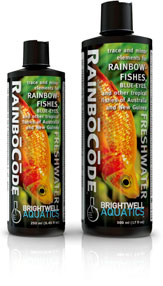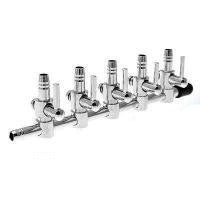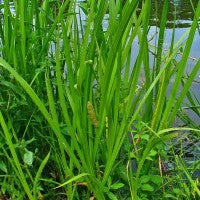Brightwell Aquatics RainbowCode Brightwell Aquatics
$ 15,75 $ 9,45
Trace & Minor Elements for Rainbow Fishes, Blue-Eyes & other Tropic Fishes of Australia & New Guinea
Overview
Unique complex that provides trace and minor elements in ratios found to be beneficial to rainbowfish and other fishes that share the same waters of origin.
Provides minor and trace elements utilized in important neurological and metabolic reactions, and which are incorporated into natural bio-pigments for coloration.
Replaces minor and trace elements used by aquarium inhabitants, and which are lost through chemical filtration (use of filtration media such as resins and activated carbon).
Composed of purified water and ultra-high purity materials.
Does not significantly increase GH or KH.
Formulated utilizing extensive research on the chemistry of the waters naturally-inhabited by rainbowfishes and blue-eyes, as well as their trace and minor element requirements.
Technical Background
The role that trace and minor elements play with rainbowfishes and other fishes is related to neurological and metabolic processes (in which these elements play critical roles), as well as overall coloration (trace and minor elements are often at the core of pigments known to enhance coloration); of these aspects, it is coloration that is often most important to the rainbowfish enthusiast, as few experienced hobbyists will deny that male rainbowfish displaying to a female are some of the most brilliantly-colored fishes maintained in captivity. Dosing a trace and minor supplement with every water change performed is an effective method of delivering these substances for maximum benefit.
Rainbowfishes and their allies, the Blue-eyes, are native to all manner of water bodies throughout New Guinea and parts of Australia. Water chemistry in these systems varies from moderately-acidic to -alkaline, and extremely-soft to -hard; while it is generally unnecessary to maintain water parameters for a given species exactly like those of their native habitat, it’s sensible to approximate these parameters (e.g. moderately-hard water and alkaline pH for species native to habitats featuring these conditions, and vice versa for fishes hailing from soft-water, acidic waters) for long-term health of the fish. That stated, the majority of rainbowfishes (with few exceptions) adapt well to a general hardness of 9 – 12 dGH (150 – 200 ppm) and pH of 6.5 – 7.5, though some may require harder or softer conditions (Blue-eyes inhabit coastal environments and do well in varying degrees of brackish water; for other species’ requirements, consult a reputable text). Maintaining immeasurable ammonia and nitrite, and <20 ppm nitrate, is more important than attaining specific pH and dGH values for long-term health of rainbowfishes.
A number of popular ornamental fish species, such as various gudgeons, gobys, and scats are often found in the same waters in which rainbowfishes and blue-eyes originate; hence, RainboCode may also be used in aquaria housing these fishes with equal success.
Instructions and Guidelines
Shake product well before using.
Community Rainbowfish Aquaria: Add ½ ml (~10 drops) of product per 25 US-gallons of aquarium water every other day. When used in this fashion, 250 ml treats up to 2,500 US-gallons (9,464 L).
Biotope Aquaria: As noted opposite, the water conditions that rainbowfishes and blue-eyes originate from in the wild is wide-ranging. It is therefore sensible to use different dosages of this product for biotope aquaria in which fishes with different requirements are housed. Use the following dosages as a general guideline for each biotope aquarium, and increase or decrease dosage as deemed necessary by the appearance of the inhabitants and overall aquarium.
Rainbowfishes endemic to acidic pH habitats: Add ¼ ml (~5 drops) of product per 25 US-gallons of aquarium water every other day.
Rainbowfishes endemic to alkaline pH habitats: Add ½ ml (~10 drops) of product per 25 US-gallons of aquarium water every other day.
Blue-eyes: Add ¾ ml (~15 drops) of product per 25 US-gallons of aquarium water every other day.
Note that starting out at a dosage of ½ those recommended above and then gradually increasing the dosage over a period of weeks is often a good practice to follow in aquaria that have not received any previous trace and minor element supplementation; doing so will not cause any harm to aquarium inhabitants, and will enable you to notice subtle changes in the appearance of the system that indicate the effectiveness and need for the product. Though trace and minor elements are essential to critical biological processes, their gross overdosing can be harmful to aquarium inhabitants. Minor and trace elements are made unavailable in aquaria largely by adsorption to particulate organic matter (POM); therefore, aquaria with large amounts of latent organic material may require slightly heavier dosing of this product to compensate for that which is bound. Note that activated carbon will remove trace and minor elements both passively and actively.
Guaranteed Analysis
Zinc (min) 0.015 mg/oz.; Iron (min) 0.0016 mg/oz.; Manganese 0.00086 mg/oz.; (min) Cobalt (min) 0.000086 mg/oz.
Ingredients
Purified water, species specific, appropriate minor and trace minerals
| Size | 250ml, 500ml |
|---|
Fast Shipping and Professional Packaging
We can offer a variety of shipping options thanks to our long-term relationship with UPS FedEx DHL. Our warehouse staff will package all goods to our exacting requirements. Prior to shipping, your goods will be thoroughly examined and securely secured. We deliver to thousands of customers every day from all over the world. This is a sign of our determination to be the largest online retailer in the world. Warehouses and distribution centers are located throughout Europe as well as in the USA.
Note: Orders that contain more than one item will be assigned a separate processing time for each item.
Prior to shipment, we examine the items ordered thoroughly before sending the items. Most orders are shipped within 48 hours. The expected delivery time is 3 to 7 days.
Returns
The stock is constantly changing and cannot be fully controlled by us due to the involvement of many different parties, such as the factory and our warehouse. The levels of stock can change at any moment. You may not receive your order once the order has been made.
The policy is 30 days. If it's been longer than 30 days since you made your purchase and we're unable to offer you a complete exchange or refund.
To be eligible for a return your item must be unused and in the same condition as you received it. You must have the item in its original packaging.
Related products
Air Pump Accessories
Maintenance Tools
Air Pump Accessories
Plant Fertilisation
Freshwater Plant
Bacteria
Freshwater Plant
Plant Fertilisation
CO2 Accessories
Uncategorized
Air Pump Accessories
Plant Fertilisation
Plant Fertilisation
Filter Media
Plant Fertilisation
Bacteria





































